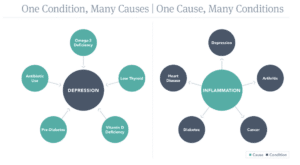You try to chew as you’re getting kids coats on, and then slam back a slug of coffee, hurriedly hustling everybody out the door.
Eating on the run has become a part of modern life. Kids or no kids, many of people are checking e-mail and doing work while they eat lunch. Slamming back food in the car while they rush from one place to another…
It’s no wonder so many people feel anxious and stressed all the time! Over time, they often end up exhausted and unable to think or focus well. Not to mention how your digestion feels through all of this… This can turn into a vicious cycle, because digestive issues can in turn negatively affect your mood. Read this to learn more about how impaired gut health can play a role in energy problems.
You can improve your digestion with mindful eating… seriously! You can improve it a lot.
Ladies, I have totally been there. Flying through meals, thinking I’m multi-tasking. It’s easy to think we’re being productive… But in reality, our minds and bodies need breaks and relaxation for us to truly be efficient, and attentive to the tasks at hand. Life often won’t give you these peaceful moments, so I give you permission to set boundaries and demand things slow down periodically throughout your day.
You deserve to have some relaxation in the midst of busy days, and what better time than during meals!
Here’s what you’ll learn in the following video OR Read the TRANSCRIPT Below:
- 1:24 What are the sympathetic and parasympathetic nervous systems?
- 2:42 How do you learn what it feels like to be in your parasympathetic nervous system?
- 4:36 Techniques for mindful eating
- 6:15 Fun ways to eat mindfully with kids
- 7:46 Mindful eating during chaotic days!
If you’re trying to figure out what foods are affecting you positively, and what foods might be problematic for you, mindful eating is a vital tool. I often have my clients track observations of their emotions, energy, and any other symptoms throughout the day. In this way, we can begin to discover patterns around what you’re eating, and how you’re feeling.
So, take one of the tips from the video, and practice it during your next meal. You might find the experience is quite rewarding!
I welcome you to share your observations or mindful eating ideas below!
TRANSCRIPT OF THE VIDEO:
Hello lovely people. Today I want to talk to you about mindful eating. Obviously we’ll discuss mindfulness a little bit, and we’ll discuss why mindful eating is important. Then I’m gonna give you some tips to start to utilize during your meal time.
Mindfulness is crazy hard. It takes a lot of practice. It’s something I continue to practice and work on on a daily basis. So, go easy on yourself if this is new for you. If you have a strong mindfulness practice, hopefully this will give you a couple more tips and some things to think about as far as integrating that when you are actually eating your meals.
I also want to comment for new moms out there that I sometimes roll my eyes or just want to laugh when people are talking about mindfulness and they’re giving tips for certain situations, because when you’re in a kitchen you’re trying to feed a bunch of kids, especially little kids, it’s laughable some of the tips that you can get. They’re still valuable, but I want to do is give you some ways that you can take those tips or take those tools, and use them in these situations with kiddos too. So we’ll talk about that as well.
Let’s talk about why we want to use mindfulness and be relaxed when we eat. What’s the point of all this? So, there’s two sides of our nervous system. We’ve got our parasympathetic nervous system and our sympathetic. Your sympathetic nervous system is where you’re at when you are stressed. It’s often referred to as fight or flight, or freeze. I always throw that in too, because a freeze response is also a stress response that your sympathetic nervous system will dominate.
We do not digest when we are in our sympathetic nervous system. So if you’re driving down the highway and someone cuts you off or you’re late somewhere, the body is not working on digestion at those times. It is prioritizing you getting out of danger essentially. Your parasympathetic nervous system is often referred to as rest and digest. This is where optimal digestion occurs, so this is where we want to be when we are eating. Avoiding stressful situations when you eat is optimal. Like I said, I always want to laugh at that too, because in a kitchen full of kids, that can be a really big challenge.
First things first, we actually need to know what relaxation feels like. One time I had somebody in a class ask me, “How do I know when I’m not stressed?” And that really struck me, because that is a big deal. If we’ve spent a lot of our life or we didn’t learn that growing up, we spend a lot of time in our sympathetic nervous system, we might not really know what it feels like to truly be in our parasympathetic nervous system. So first things first is taking time to practice being in the parasympathetic, or being in relaxation when we’re not in stressful situations.
So if you do have kids and that scene in the kitchen happens for you, then prioritize finding some time to practice mindfulness when the kids are asleep or they’re at school or daycare or whatever and you have even five minutes. This might be something that you can figure out to do on a lunch break at work. I’ve got little kids, and I do it right after they go to bed or right before I go to bed, and even if it’s a busy day, I’ll just make sure. What is five minutes, right? If I get to bed five minutes later and that five minutes actually promotes better sleep, then it’s all worth it.
I will do this right before bed. I often still use Insight Timer, which is an app that you can put on your phone, sit and do like a five minute meditation. Other times if I might listen to someone else do a guided type of thing, so check that out. Find something like that if you would like to have something to hold you accountable that’s there and tracks you doing it every day. I’m not gonna go into actual teaching meditation right now, but I will definitely post some more content on that in the future. But start to do that, is find that time where you’re away so that you can start to feel what it feels like when your system really relaxes.
Here’s some ways to then take that and put it into mealtime. Three deep breaths before you start eating. Now if you’re sitting with other people and you don’t want to share with them what you’re doing, that’s fine. You can take three really relaxed breaths while listening to them talk, in between sharing things. The idea is to let your body really sink into the chair, feel your tush in the seat, feel your arms maybe relax on the arms of the chair. One thing that works really well for me is feeling like there’s weights in my hands and weights in my feet.
So if I really sense my hands and feet, that seems to help me ground and relax. I’ll kind of feel my whole body settle into the room. So, lots of different tools for that, but find something that helps you feel your body in the space, and then take some deep breaths. Just start with that three deep breaths before you eat, because at least then you’re starting to just send a message to your body to calm down before you start consuming food.
Do it as a family. We started just, we call it family breath. Even the baby does it. She’s going on two, but she thinks it’s hilarious, and we all hold hands and we take a deep breath together, just one deep breath. It’s just a reminder to us all to kind of come together and eat. If you have a prayer practice or any other sort of practice that you do before you eat, that’s great too. Just use that time to also feel your body, feel your breath, and really relax and settle before you eat.
Tip number two would be that during the meal you can initiate some conversation about senses and what you’re noticing while you’re eating. With little kids, you could literally talk about how the food feels in your mouth. Is this soft, is this rough, is this sweet or is it sour or bitter, and just kind of talking about how the food feels. That’s one way to keep everybody present and thus you present. Sometimes I will just comment on things outside of the window like noticing what the sky looks like, or noticing what the trees look like as the wind blows them.
For me, nature is a really, really big thing that I like to keep incorporated for relaxation. I will notice even when I just look out the window that I sort of settle into the space and almost space off into relaxation. Everybody’s gonna be different, so find something for you that helps you feel present. You can just comment on that here and there. Sometimes people are like, “What is she talking about?” That’s okay. I always like to remind everybody and you moms that if mama ain’t happy, ain’t nobody happy, even if they think you’re a little bit weird, that’s all right as long as it keeps you present. I have a little friend here. Say hi [Tobin 00:07:42].
Okay, tip number three is for those moments when a family meal is just not in the cards, total chaos in the kitchen, or it’s just one of those mornings that you’re trying to get everybody out the door to work. For those of you laughing, again, I can feel myself start to laugh when I say things because I’m like, “What morning isn’t crazy trying to get everybody out the door to school?” All those moments where you just have a lot going on and we need to reconnect to mindfulness through the chaos, see if you can just find a different time to eat.
When I have really busy mornings and I know that I’m hungry and I need breakfast, I just put it in a container and take it to work, and will take whatever time I have when I get there to try to eat calmly. Even if you know that, “Oh I’m at work, I need to start working,” and you’re going to also eat at the same time, sometimes we just have to do that. So still find those mindfulness moments. Even if you’re reading through some email and trying to get started on your day and you know that today isn’t a day that it’s gonna happen, that I have this wonderful little window of time where I can eat calmly, quietly, and have this great mindful eating experience, go back and forth between, “Now I’m reading that email and now I’m taking a deep breath and chewing my food and swallowing,” so that you’re still practicing mindfulness even if we’re going back and forth between being mindful towards what we’re doing and then being mindful towards reading.
It is a lot of practice in those situations, but it’s all a good practice, and it will all at least bring more awareness to what you’re doing during meal time. If it’s dinner time and you get into a conversation with your partner or a kid, or even a friend if you’re out to eat, that gets heated or you’re in a heated debate, stop eating. See if you can finish that conversation and then resettle before you take your next bite. My family is totally notorious for getting together and having heated, highly excitable debates. Through the years, I oftentimes will find myself not really engage in that when I’m actually eating.
If that is something that happens with your family, debating and all of that, that can be great and fun and have a place, but while you’re eating it’s just gonna get you in sympathetic nervous system and play against you when it comes to digestion. So just notice if this is happening when you’re eating in your conversations, or use some of these tools to bring yourself back to body awareness, breath, and noticing when you’re really relaxed. Keep just coming back to that. You’re gonna get pulled out of it, and that’s part of why it’s a practice is just noticing when that happens and then bringing yourself back into that relaxation response.
I hope this gives everybody some food for thought. Mindfulness, as I said, and mindful eating, is a practice. It’s ongoing, so take one of the tips and start to integrate it into your meals and your mealtime. Just see what you notice. Share any of your discoveries on the blog. I would love to hear about them. I will continue to share mine with you as well. If you have any friends or family that you think this could help, I’d love it if you would share it with them and hopefully they will find some good tools to use for themselves as well. Have a lovely day.




